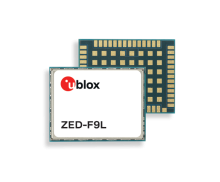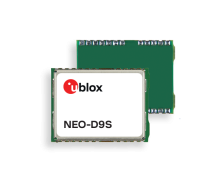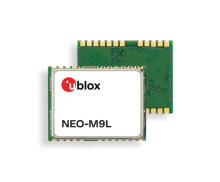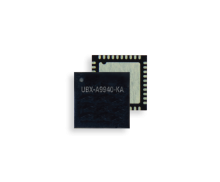
ZED-F9K module
High precision dead reckoning with integrated IMU sensors
Imagine traveling without steering your vehicle’s wheel. With the automated driving system engaged, you could drive for many kilometers without looking at the road.
What would you do, enjoy the view, read a book, watch a movie, play some video games, or relax and nap, waking up right before you reach your destination? In the not-so-distant future, all this will be possible.
Yes, those futuristic scenes of George Jetson ‘driving’ his vehicle with his legs lying down on the car’s dashboard without moving a finger are just around the corner.
Innovations in ADAS systems and self-driving vehicle technologies are driving the future of fully autonomous vehicles.
Advanced Driver Assistance Systems (ADAS) are a suite of technologies designed to improve vehicle safety on the road. Using sophisticated sensors, GNSS, cameras, and radars, vehicles equipped with ADAS systems monitor the car’s position on the road, speed, and surroundings for potential hazards.
These technologies work together to continuously collect positioning and safety data about the vehicle’s environment. The ADAS system analyzes the collected data in real time to understand what's happening on the road.
ADAS systems have five autonomous driving levels, based on the degree to which the vehicle can operate independently of human intervention. They range from Level 0, where there is no automation, to Level 5, where the vehicle is fully autonomous and requires no human input. Each level represents increasing autonomy and the vehicle’s ability to handle driving tasks.
Depending on the vehicle’s level of autonomy, ADAS functions can take over the driver's control up to L2/L2+, while still remaining under the driver’s responsibility, or they can operate fully autonomously from L3 up to L5. Common ADAS/AD functions include adaptive cruise control, automatic emergency braking, lane departure warning and lane keep assist, blind-spot monitoring, and parking assistance.
GNSS technology is the cornerstone of ADAS and autonomous driving because it’s the only technology that enables absolute accuracy in positioning, navigation, and timing.
By leveraging signals from multiple satellite constellations, GNSS receivers can accurately calculate a vehicle's position, even in challenging urban environments or adverse weather conditions.
The received signal is processed by complex algorithms capable of fusing the received information with the signal from Inertial Measurement Units (IMU) and from augmentation services to output an accurate absolute position that is resilient to poor satellite visibility (dense urban environments) or signal loss (for example, when passing under bridges or tunnels where the sky is not visible).
Inertial Measurement Units (IMUs), comprising accelerometers and gyroscopes, measure the vehicle's linear and angular motion. By integrating acceleration and rotation rate data over time, IMUs continuously estimate position, velocity, and orientation. While valuable for short-term localization to compensate for temporary satellite signal loss, IMU accuracy may drift over time without external reference updates.
GNSS augmentation systems, such as PPP- RTK, improve accuracy down to the decimeter level in real time through a network of sufficiently sparse ground stations capable of calculating positioning corrections, including satellite orbit and clock corrections, atmospheric delays, and ionospheric corrections.
Depending on the level of ADAS, vehicles need to determine their position in relation to their environment and the road topology. This is essential for deciding the correct maneuver for each situation.
Typically, positioning functions rely on multiple inputs (camera, radar, HD-MAPs, IMU, GNSS, and other technologies). However, the GNSS is the only sensor that provides absolute positioning with decimeter-level accuracy. It is also available in conditions where other sensors may be compromised.
By leveraging GNSS capabilities, autonomous driving systems can create geofences to enable specific functions and/or improve positioning accuracy and availability, extending operational capabilities even in challenging environments where traditional sensors may fail.
Geofencing, a critical component of ADAS and autonomous driving systems, enables the creation of virtual boundaries, such as specific roads or lanes, where autonomous driving can be safely enabled. GNSS technology is fundamental to geofencing because it provides accurate vehicle location data. On-board GNSS receivers continuously receive signals from satellites and determine the vehicle's position coordinates (latitude and longitude). These coordinates are then used to verify that a particular autonomous driving feature can be safely enabled (for example, an automatic traffic jam function might only be enabled on a highway section with no intersections).
The importance of reliable localization accuracy in ADAS and autonomous vehicles cannot be overstated. GNSS is critical to improving localization in autonomous driving due to its ability to provide accurate positioning information over vast areas and diverse terrains. Unlike traditional sensors, GNSS operates independently of local infrastructure and can provide continuous positioning data even in challenging environments such as urban or rural areas with limited landmarks. This reliability and comprehensive coverage enable autonomous vehicles to maintain precise localization, crucial for safe navigation and decision-making in dynamic driving scenarios.
Once a vehicle relies on its current position for automated driving, it must make safe decisions. These decisions raise the issue of trustworthiness/ and integrity, which must be diligently addressed as human lives are at stake.
This requires an integrity concept, defined as 'the measure of trust that can be placed in the correctness of the information supplied by the positioning system'. Potential risks to integrity can be grouped into vehicle hardware and software malfunctions, environmental factors, and unintentional misuse. In the automotive domain, the risk of using unsafe information should be guaranteed to be as low as 10-7 and 10-6 per drive (one drive equals one hour).
Safe and high-integrity GNSS ensures that vehicle location data is trustworthy and precise, reducing the risk of accidents and improving overall system reliability, which is paramount for the safety of passengers, pedestrians, and other road users.
This is fundamental for high levels of automation, where the vehicle makes maneuvering decisions.
Automotive standards have been introduced to cover methodologies to minimize the risks associated with hardware, systematic development faults (ISO26262), or performance deficiencies in the implementation of electrical and/or electronic (E/E) elements in the system due to, for example, environmental conditions (ISO21448).
The wide variety of autonomous vehicle architectures, features, and sensors requires a myriad of highly accurate and reliable positioning solutions. u-blox’s portfolio is broad, enabling the adaption to multiple OEM E/E architectural designs.
They can also be integrated into different DCUs (ADAS, Infotainment, and Telematics) or ECUs designed for positioning/location functionality. Positioning solutions include hardware components with GNSS receivers, software components including dead reckoning (DR), RTK algorithms, cloud-based support, and correction services for decimeter-level accuracy when required.
Requirements differ according to ADAS levels. Adapting to the requirement levels and using vehicle positioning information therefore means offering a range of solutions. These include multi-band solutions for sub-meter accuracy, multi-band solutions with SSR/OSR correction service for high accuracy, and pre-certified safe solutions according to ISO 26262 and 21448.
With over 25 years in the automotive market, we have a proven track record in engineering high-precision positioning solutions. We are present in over 60% of the (sizeable) market.
u-blox's unparalleled expertise in high-precision positioning and commitment to functional safety standards make us the premier partner for ADAS and autonomous driving solutions.
Our commitment to functional safety ensures that our products meet the most stringent safety requirements, giving our customers peace of mind as they navigate the challenges of ADAS and autonomous driving development.
u-blox delivers the technologies for tomorrow’s hands-free driving experience. As the premier source for wireless and embedded positioning technologies, we enable automotive OEMs to save resources and achieve faster time-to-market.

High precision dead reckoning with integrated IMU sensors

Sub-meter dead reckoning GNSS with integrated IMU sensors
GNSS correction service

u-blox D9 correction data receiver

u-blox M9 automotive dead reckoning module with 3D sensors

u-blox A9 functional safe GNSS chip

Easy evaluation of ZED-F9K with multi-band RTK
Safe positioning service
u-blox A-GNSS services
Contact us and we'll be in touch as soon as possible: